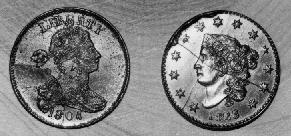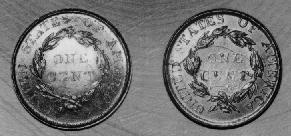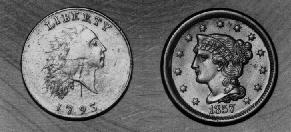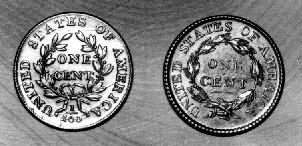
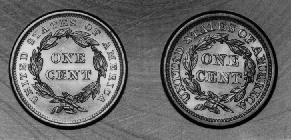
Have you ever wondered about the source of the numismania epidemic that has run rampant in our country for over a century? You are infected with it, or you wouldn't be reading this. I too am a carrier, or I wouldn't be writing this. Neither of us are nobility, so how came we of the "middle" or "ordinary" class of Americans to embrace the "hobby of kings," as numismatics has been rightly called for several centuries?
Well, we're going to explore that question. And enroute to satisfying our curiosity we expect to have some fun, because that's what hobbies are about.
At the birth of this nation we were mostly of European stock, with the habits, value-systems, and mindset that go with that heritage. Certainly we were a poor, struggling babe of a nation - if we could even be called that yet - but even then we had our own variant of what our continental forebears had dubbed "nobility," or the "ruling class." These prosperous merchants, bankers, traders, and growers included some with tastes that had been brought across the Atlantic and the assets to indulge them. Yes, when our new republic struck its first circulating coins in 1793, we already had some coin collectors here. But the paucity of high-grade coins from this era shows how few these early U.S. collectors were.
And nothing changed that situation for over sixty years. But in 1857 a dull, dry coinage law sparked an interest that hasn't died in over a century.
The legal tender act of 1857 was needed to put the federal mint back on a profitable basis. By law, precious metal had always been coined at a loss, with base-metal coinage making enough profit to carry the whole operation. But by 1857 it cost over a cent apiece to make and distribute the large copper cents. Their retirement for the radically different small white cents began a popular scramble. Thousands of common people like you and me tried to build a run of these old cents before they vanished. After all, it would cost less than a dollar to do it from change.


So successful was the one-two punch of an active government campaign to retire the large cents and a growing surge of beginning collector/hoarders that within a decade there was a major shortage of circulating change. And yet, today, small change of that period is quite plentiful among collectors.
The first decade after the passing of the large cents saw the first coin auction in America (a collection of large cents), the genesis of full-time coin dealers in this country, and the first offering by the mint to the general public of sets of specimen struck coins.
As collecting progressed to study, the next twenty years saw the rise of the "specialist" - one who learns more and more about less and less, until he publishes a book to prove to the world how much he knows about how little. And of course the large copper cent that started the whole thing was the favorite topic of most numismatic writers. More has been written of this series than any three others combined - even more than the frantically ballyhooed Morgan dollar.
So we've answered our first question - what was the popular parent of our current dementia. But we haven't looked yet at the old coppers themselves. What about them holds a fascination that would impel a nut like me to gather a thousand or more of them and arrange, study, and cherish every one of them?
For one, they have individual character. Copper is a chemically active metal, and a century or two can give it a variability unmatched by the nobler metals. Die work, though not crude, certainly seems so by today's standards. Mispunched letters, missing or manually added design elements, and outright blunders of the diecutter's art abound in this series. Some of the designs are beautiful. But some of the uglier ones have so much charisma that they are favorites over their prettier sisters.
And then there's the physical condition of the dies themselves, as they hammered out hundreds after hundreds of coins, wearing themselves down, cracking, losing chunks of themselves, injuring each other by banging together without a coinbank in place, and suffering the humiliation of heavy grinding to efface surface scars and stretch more miles of service from them. Some collectors revel in spreading out a dozen or more cents from the same pair of dies - with no two of them alike.
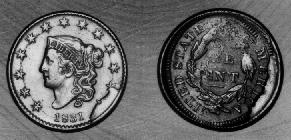
And what of the planchet goofs, the striking blunders, and the many abuses suffered by the struck cents over the many decades since they were made? Did that large square nail hole come from being fastened to a beam or doorpost? This was once thought to insure good luck to the owners of the new home. Maybe this corroded wretch of a cent was dropped into the pickling brine to make a brighter green in the pickles. And this one with two round holes in it - was it a button? Or perhaps it was a humdinger (let me tell you about those sometime).
This lovely 1818 cent probably came from the original mintsealed keg found around 1867, and that gorgeous 1821 was likely one of the small hoard removed from a building cornerstone in Boston in 1981. But what about this lovely 1805? Who put it away? How many days after it was made? What famous men over the years have paid their fee to act for a while as its protector? And what of this worn out 1794? If only it could talk! What has it bought? Through what historic events did it hide in the dark of a history-maker's pocket? How many times has it been lost and found? Where has it traveled?
Was this almost-slug of 1793 chain cent handled by anybody whose name I would recognize? Likely so, as they were all distributed in our nation's capitol, and with 36,103 coins and 54,000 Philadelphians there were enough for two in every three to have one. And this coin has certainly been spent a LOT of times!
Yes, variability is a big factor in the lure of the old coppers. And beauty is another; and mystery is another. As Sheldon put it in Penny Whimsy, "Every early cent has a character of its own." The speculative stories each of these old coppers could tell are fascinating. But as individual coins, speculation is all we have. If we step back and look over these coins as a group, the story is clearer - just as histories of individual people are usually vague while histories of nations are better documented.
Our story begins on March 1, 1793. For several years the Continental Congress had considered a federal coinage. Six years before a contract coinage was tried, even to specifying the designs and providing 35 1/2 tons of federal copper for it. The contractor, James Jarvis, delivered about 4 1/2 tons of coppers, subverted the rest of the tonnage to his own use, and slipped away to France before the warrant for his arrest could be served. These coppers, bearing the Latin word "FUGIO" (I fly), referred to fleeting time - and, with tongue in cheek, to Jarvis as well.
The privately produced Washington portrait patterns of 1791 were rejected as "monarchial" by our president, so we purchased, in 1792, a property for a federal mint and produced a few other variants as proposal patterns. The design adopted marries a clone of Birch's Liberty head to a descendant of Franklin's circle of chain links - one for each of the fifteen states then in the union, since Vermont had been admitted two years earlier and Kentucky a year later.
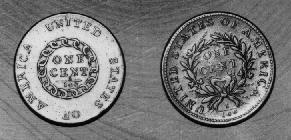
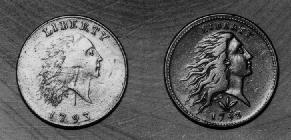
The offending chain was replaced with a laurel wreath (for victory, as in "winning your laurels"), and the ugly head (dubbed "a squaw in a fright") was strengthened and beautified. This design was obviously popular, as several have been saved as keepsakes. The 63,353 wreath cents made over the next four months showed a higher than average survival rate.
Being young, our government could perhaps have been forgiven for not having heard the adage "if it ain't broke, don't fix it," as they replaced a popular design with an inferior one. Our first half cents - 35,334 of them - were made in the hiatus between the wreath and liberty cap cents. These half cents have the liberty-with-cap design copied from the French "Libertas Americana" medal of 1787, with the head and hair in full high relief as on the wreath cents.
At the height of the most virulent yellow fever epidemic ever to hit Philadelphia, 11,056 cents were made with a right-facing liberty-with-cap design in much lower and simpler relief. Over half of the city's population had fled to the country, and one in six of those who remained would die of the fever between August and October, including the mint's new chief engraver. The 1793 liberty cap cent, the rarest year-type combination of the entire large cent series, probably represents the output of only a few days' striking.
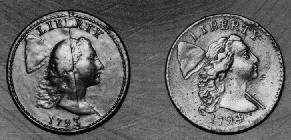
By 1795, the price paid for scrap copper from ship fittings, cannon, copper nails, kitchen utensils, and the like had risen enough that the mint director found it necessary to petition President Washington to allow a twenty percent weight reduction on cents and half cents. The reduced weight made a thinner, same-diameter coin, eliminating the edge lettering "ONE HUNDRED FOR A DOLLAR" (dream on, dream on).
John Harper lobbied for a contract to make coins for the U.S., and Congress considered the federal mint as a waste of taxpayers' money. But after seeing the low quality of his samples (later to be dubbed "Jefferson head" cents), and possibly being reminded of the Jarvis fiasco, Congress rejected his overtures. Gold was added to the output that year, with a striking of 8,707 half eagles and 5,583 eagles, and a move into the big time came with the first coinage distribution outside of Philadelphia.
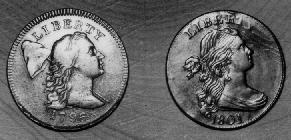
1796 was the first full-coinage year, with all ten denominations originally authorized being struck. That a few well- heeled collectors set aside the requisite nineteen dollars and forty-one and a half cents to preserve a choice run of the year is proven by the existence of such coins nearly two hundred years later. And the quarter-million-dollar price tag of such a set today is proof of how few actually did this. The magnitude of this all-denomination coinage feat is little appreciated. It would be another fifty-three years before it happened again.
Late in 1797, the first shipment of British planchets, from Boulton of Birmingham, was struck into cents, and Congressman Benjamin Goodhue bought a thousand new cents at his tour of the mint. Held intact for seventy years, this hoard would become known as the "Nichols find" when it was dispersed by his granddaughter (married name, Nichols) after collector fever had spread. The British source gradually grew to dominate our copper purchases, reaching almost monopoly proportions by 1816, and waning as larger domestic suppliers geared up in the 1820's and 1830's.
In 1799 we mourned the death of the father of our country ("he is in Glory, the nation in tears"), and a new federal Capitol would be built the following year at a site selected by Washington in 1791. The new city on the banks of the Potomac was named in his honor. Not until sixty years later would Americans realize the scarcity of cents dated 1799. In the succeeding century, many fabricators of varying skills tried to ease this shortage by altering the dates on many hundreds of more common 1798 cents.
By 1803, over 15.5 million cents had been minted, with less than 3.5 million pieces of all other denominations combined. The total mintage of our first eleven years took a half shift with coffee break (3.5 hours) at 1985 production rates. The coin factory remained in Philadelphia rather than moving south with the politicians.
In reacquiring the Louisiana territory from Spain in 1800, France guaranteed not to transfer the territory to any power other than Spain. Nevertheless, within three years the French sold this vast territory to the U.S., doubling our size and almost costing us two states, as New York and Massachussetts threatened to secede in protest. The French needed money to feed Napoleon's wars.
With Napoleon prowling Europe, shifting alliances and distrusts involved most European powers in one war after another for the next decade. During the War of 1812, Britain cut off the supply of copper planchets. The mint had become so dependent on this source that planchets ran out in 1814 and production stopped.
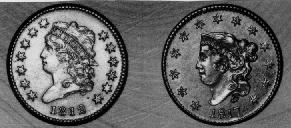
Charitably dubbed the "matron head" design by latter-day numismatists, this abomination was representative of a period when all U.S. coin designs were mediocre at best. And yet the matrons have a charm that the later stereotyped issues will never be able to match. The days of the individually distinctive die were drawing to a close. With the extension of the Erie Canal and the lure of government land, homesteaders spread across the western wilderness of Ohio, Indiana, and on to the Mississippi. Federal money circulated mostly on the east coast, somewhat in the "western reserve," and not at all in the Spanish dominated far west.
Domestic copper supplies finally eliminated British copper from our cents, but Brittania had one last laugh on us as the new coinage designs of the mid-1830's were a mere revamp of the Brittania so avidly copied by our copper-coining ex-colonists of fifty years earlier. The head on the cent was trimmed and improved as our nation slid into the deepest financial depression in memory.
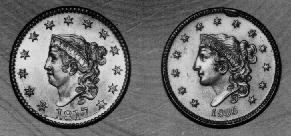
The United States continued to grow by leaps and bounds as European immigrants poured into the eastern seaboard and they and other settlers pushed westward. Between Wisconsin and Oregon was still mostly Indian territory. Until the discovery of gold in California, Mexican money continued to predominate in the Southwest and West Coast.
This discovery electrified the nation, and spurred many thousands to travel by land and sea to California. Thousands of U.S. farmers and hundreds of Uruguayan and Argentinian shepherds streamed into the gold fields. Gold had its way of cutting red tape; California was granted statehood in record time. A branch mint in San Francisco coined California gold, then silver, but it would be almost sixty years before copper was coined there.
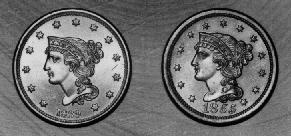
By late 1856 Director Snowden had the ear of Congress, and a new, partly-nickel, cent of much-reduced weight was authorized. The design of the new white cent stole the eagle from Gobrecht's 1836 silver dollar and the wreath from Longacre's 1854 gold dollar.
To palm this debasement off on the public, the new cent was made "legal tender" - a status previously denied to base-metal coinage in this country. This meant that by law this money must be accepted by any creditor at face value.
The recall of the large cent precipitated a popular interest that would grow to a pastime and later to a mania - native American numismatics. But we can't stop here without introducing a couple of fascinating aftereffects.
Since before the "hard times" of the late 1830's (do these run in hundred-year cycles?), the chief and growing debate had been over slavery. This irresolvable question was bigger than the profit or loss from our coining operations and shortly led to the darkest chapter of our history - a dissolution of our Union, the devastation of great parts of our country, and the legalized murder of over six hundred thousand Americans by their countrymen.
During the hostilities, not only personal valuables but also business valuables were hidden whenever possible from the invading armies. A few years after the war, a contractor was engaged to tear down an old railway station in Georgia. Under the loading dock was found one or more kegs - later guesses say likely seven or so - of bright red fifty-year-old cents. How would YOU like to find a thousand dollars worth of uncirculated 1816-1820 cents?
The redemption window had passed, but he convinced a New England store to accept them at face toward his debt. When their customers refused them as "counterfeit" and the banks refused them as well, the remainder (nearly all) were sold to coin dealer J. S. Randall at ninety cents a hundred. It took decades to disperse the "Randall hoard." By 1912, these cents cost ten cents each or six dollars a hundred. By 1950 they ran six to ten dollars apiece. By 1985 they cost even more.
But not all entrepeneurs waited for a hoard of old coins to drop into their laps. In the late 1850's one enterprising soul found, in a load of scrap steel bought from the mint, several old, rusted, broken, but usable dies. Use of the precious-metal dies would be counterfeiting - a capital offense. But the base-metal dies were intended for non-legal tender coins. One can't be charged with counterfeiting what isn't money.
